SLVSAS4J June 2013 – April 2017 TPS7H1201-HT
PRODUCTION DATA.
- 1 Features
- 2 Applications
- 3 Description
- 4 Revision History
- 5 Pin Configuration and Functions
- 6 Specifications
- 7 Detailed Description
- 8 Application and Implementation
- 9 Power Supply Recommendations
- 10Layout
- 11Device and Documentation Support
- 12Mechanical, Packaging, and Orderable Information
Package Options
Mechanical Data (Package|Pins)
- HKS|16
- KGD|0
Thermal pad, mechanical data (Package|Pins)
Orderable Information
6 Specifications
6.1 Absolute Maximum Ratings
over operating free-air temperature range (unless otherwise noted)(1)
(1) Stresses beyond those listed under Absolute Maximum Ratings may cause permanent damage to the device. These are stress ratings only, which do not imply functional operation of the device at these or any other conditions beyond those indicated under Recommended Operating Conditions. Exposure to absolute-maximum-rated conditions for extended periods may affect device reliability.
6.2 ESD Ratings
| VALUE | UNIT | |||
|---|---|---|---|---|
| V(ESD) | Electrostatic discharge | Human-body model (HBM), per ANSI/ESDA/JEDEC JS-001, all pins(1) | ±2000 | V |
| Charged-device model (CDM), per JEDEC specification JESD22-C101, all pins(2) | ±1000 | |||
(1) JEDEC document JEP155 states that 500-V HBM allows safe manufacturing with a standard ESD control process.
(2) JEDEC document JEP157 states that 250-V CDM allows safe manufacturing with a standard ESD control process.
6.3 Recommended Operating Conditions
over operating free-air temperature range (unless otherwise noted)| MIN | NOM | MAX | UNIT | |||
|---|---|---|---|---|---|---|
| TJ | Operating junction temperature | –55 | 210 | °C | ||
| tR EN | Rise time (10% to 90%) for EN signal | 100 | µs | |||
| tR VIN | Rise time (10% to 90%) for VIN = EN | 1 | ms | |||
6.4 Thermal Information
| THERMAL METRIC(1)(3) | TPS7H1201-HT | UNIT | |
|---|---|---|---|
| HKS (CFP)(2) | |||
| 16 PINS | |||
| RθJA | Junction-to-ambient thermal resistance | 75.4 | °C/W |
| RθJC(top) | Junction-to-case (top) thermal resistance | 0.4 | °C/W |
| RθJB | Junction-to-board thermal resistance | 64.8 | °C/W |
| ψJB | Junction-to-board characterization parameter | 53.5 | °C/W |
| RθJC(bot) | Junction-to-case (bottom) thermal resistance | N/A | °C/W |
(1) Maximum power dissipation may be limited by overcurrent protection.
(2) Power rating at a specific ambient temperature TA should be determined with a junction temperature below 220°C. This is the point where distortion starts to substantially increase. Thermal management of the PCB should strive to keep the junction temperature at or below 220°C for best performance and long-term reliability.
(3) Test board conditions:
- 2.5 inches × 2.5 inches, 4 layers, thickness: 0.062 inch
- 2-oz. copper traces located on the top of the PCB
- 2-oz. copper ground planes on the 2 internal layers and bottom layer
- 48 (0.010-inch) thermal vias located under the device package
6.5 Electrical Characteristics
1.5 V ≤ VIN ≤ 7 V, VOUT(target) = VIN – 0.3 V, IOUT = 10 mA, VEN = 1.1 V, COUT = 22 µF, PG terminal pulled up to VIN with 50 kΩ, over operating temperature range (TJ = –55°C to 210°C), unless otherwise noted. Typical values are at TJ = 25°C.| PARAMETER | TEST CONDITIONS | MIN | TYP | MAX | UNIT | ||||
|---|---|---|---|---|---|---|---|---|---|
| VIN | Input voltage range | 1.5 | 7 | V | |||||
| VFB | Feedback terminal voltage | 1.5 V ≤ VIN ≤ 7 V | TJ = 125°C | 0.593 | 0.605 | 0.617 | V | ||
| TJ = 210°C | 0.580 | 0.605 | 0.630 | ||||||
| VOUT | Output voltage range | 0.8 | VIN – 0.2 | V | |||||
| Output voltage accuracy | IOUT ≤ 0.5 A, 1.5 V ≤ VIN ≤ 7 V, VOUT = 6.8 V(1) |
TJ = 125°C | –2% | 2% | |||||
| TJ = 210°C | –4.2% | 4.2% | |||||||
| ΔVOUT%/ ΔVIN | Line regulation | 1.5 V ≤ VIN ≤ 7 V | –0.07 | 0.01 | 0.07 | %/V | |||
| ΔVOUT%/ ΔIOUT | Load regulation | 0.8 V ≤ VOUT ≤ 6.8 V, 0 ≤ ILoad ≤ 0.5 A | 0.0125 | %/A | |||||
| ΔVO | DC input line regulation | 1.5 V ≤ VIN ≤ 7 V, VOUT = 0.8 V, IOUT = 10 mA, TJ = –55°C(2) |
0.5 | 3 | mV | ||||
| 1.5 V ≤ VIN ≤ 7 V, VOUT = 0.8 V, IOUT = 10 mA, TJ = 25°C(2) |
0.2 | 0.6 | |||||||
| 1.5 V ≤ VIN ≤ 7 V, VOUT = 0.8 V, IOUT = 10 mA, TJ = 125°C(2) |
0.2 | 1 | |||||||
| 1.5 V ≤ VIN ≤ 7 V, VOUT = 0.8 V, IOUT = 10 mA, TJ = 210°C(2) |
0.84 | 3 | |||||||
| 1.5 V ≤ VIN ≤ 7 V, VOUT = 1.2 V, IOUT = 10 mA, TJ = –55°C(2) |
0.5 | 3 | |||||||
| 1.5 V ≤ VIN ≤ 7 V, VOUT = 1.2 V, IOUT = 10 mA, TJ = 25°C(2) |
0.2 | 0.6 | |||||||
| 1.5 V ≤ VIN ≤ 7 V, VOUT = 1.2 V, IOUT = 10 mA, TJ = 125°C(2) |
0.2 | 1 | |||||||
| 1.5 V ≤ VIN ≤ 7 V, VOUT = 1.2 V, IOUT = 10 mA, TJ = 210°C(2) |
0.84 | 3 | |||||||
| ΔVO | DC output load regulation | VOUT = 0.8 V, 0 ≤ ILoad ≤ 0.5 A, TJ = –55°C(2) | 0.05 | mV | |||||
| VOUT = 0.8 V, 0 ≤ILoad ≤ 0.5 A, TJ = 25°C(2) | 0.05 | ||||||||
| VOUT = 0.8 V, 0 ≤ ILoad ≤ 0.5 A, TJ = 125°C(2) | 0.07 | ||||||||
| VOUT = 0.8 V, 0 ≤ ILoad ≤ 0.5 A, TJ = 210°C(2) | 0.51 | ||||||||
| VOUT = 6.8 V, 0 ≤ ILoad ≤ 0.5 A, TJ = –55°C(2) | 0.10 | ||||||||
| VOUT = 6.8 V, 0 ≤ ILoad ≤ 0.5 A, TJ = 25°C(2) | 0.04 | ||||||||
| VOUT = 6.8 V, 0 ≤ ILoad ≤ 0.5 A, TJ = 125°C(2) | 0.05 | ||||||||
| VOUT = 6.8 V, 0 ≤ ILoad ≤ 0.5 A, TJ = 210°C(2) | 0.47 | ||||||||
| VDO | Dropout voltage | IOUT = 0.5 A, VOUT = 6.8 V, VIN = VOUT + 0.1 V | 55.5 | 100 | mV | ||||
| ICL | Programmable output current limit range | VIN = 1.5 V, VOUT = 1.2 V, PCL resistance = 47 kΩ | 500 | 700 | mA | ||||
| VIN = 1.5 V, VOUT = 1.2 V , PCL resistance varies | 200 | 700 | |||||||
| VCS | Operating voltage range at CS | 0.3 | VIN | V | |||||
| CSR | Current sense ratio | ILOAD / ICS, VIN = 2.3 V, VOUT = 1.9 V | 47394 | ||||||
| IGND | GND terminal current | VIN = 1.5 V, VOUT = 1.2 V, IOUT = 0.5 A | 13 | 20 | mA | ||||
| IQ | Quiescent current (no load) | VIN = VOUT + 0.5 V, IOUT = 0 A | 12 | 17 | mA | ||||
| ISHDN | Shutdown current | VEN < 0.5 V, 0.8 V ≤ VIN ≤ 7 V | 15 | 4500 | µA | ||||
| ISNS, IFB | FB/SNS terminal current | VIN = 7 V, VOUT = 6.8 V | 1 | 10 | nA | ||||
| IEN | EN terminal input current | VIN = 7 V, VEN = 7 V | 6.75 | 610 | nA | ||||
| VILEN | EN terminal input low (disable) | 3.5 V < VIN < 7 V | 0.30 × VIN | V | |||||
| VIHEN | EN terminal input high (enable) | 3.5 V < VIN < 7 V | 0.75 × VIN | V | |||||
| Eprop Dly | Enable terminal propagation delay | VIN = 2.2 V, EN rise to IOUT rise | 650 | 1000 | µs | ||||
| TEN | Enable terminal turn-on delay | VIN = 2.2 V, VOUT = 1.8 V, ILOAD = 0.5 A, COUT = 220 μF, CSS = 2 nF |
1.4 | 1.6 | ms | ||||
| VTHPG | PG threshold on | No load,VOUT = 1.2 V and VOUT = 6.8 V | 84% | 90% | |||||
| VTHPGHYS | PG hysteresis | 1.5 V ≤ VIN ≤ 7 V | 2% | ||||||
| VOLPG | PG terminal output low | IPG = 0 mA to –1 mA | 73 | 300 | mV | ||||
| ILKGPG | PG terminal leakage current | VOUT > VTHPG, VPG = 7 V | 0.02 | 20 | µA | ||||
| ISS | SS terminal current | VIN = 1.5 V to 7 V | 2.5 | 6.3 | µA | ||||
| ISSdisb | SS terminal disable current | VIN = 1.5 V to 7 V | 5 | 13 | µA | ||||
| VSS | SS terminal voltage (device enabled) | VIN = 1.5 V to 7 V | 1.2 | V | |||||
| PSRR | Power-supply rejection ratio | VIN = 2.5 V, VOUT = 1.8 V, COUT = 220 μF |
1 kHz | 45 | dB | ||||
| 100 kHz | 20 | ||||||||
| VN | Output noise voltage | BW = 10 Hz to 100 kHz, IOUT = 500 mA, VIN = 2 V, VOUT = 1.8 V |
20.26 | µVRMS | |||||
| TJ | Operating junction temperature | –55 | 210 | °C | |||||
(1) Based upon using 0.1% resistors.
(2) Line and load regulations done under pulse condition for T < 10 ms.
6.6 Typical Characteristics
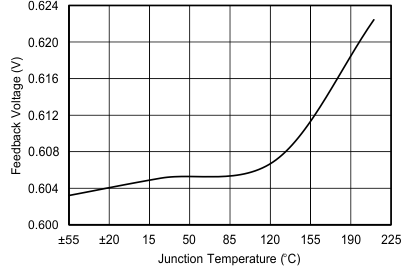

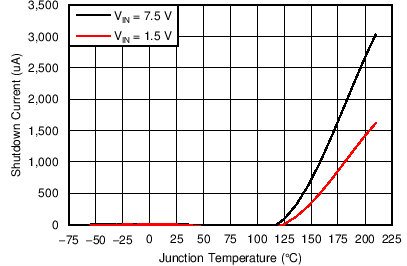
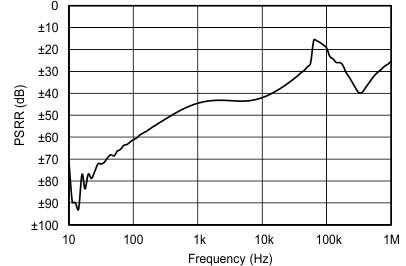
IOUT = 250 mA
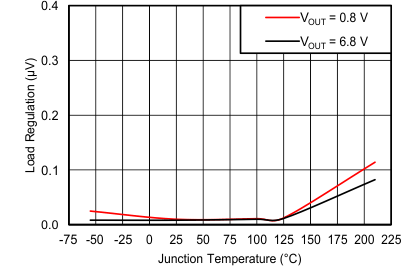
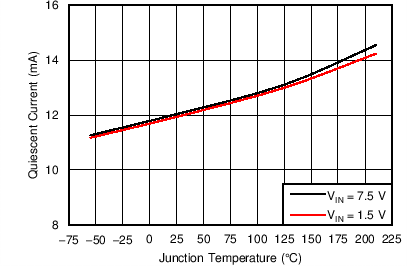
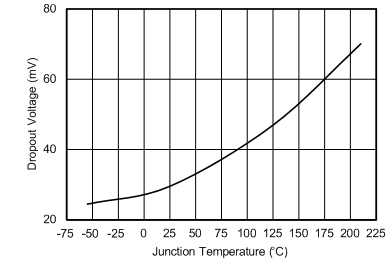
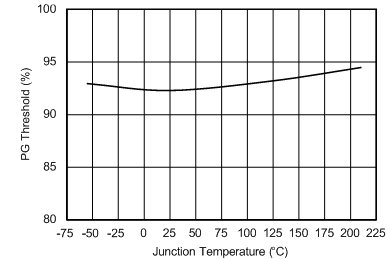
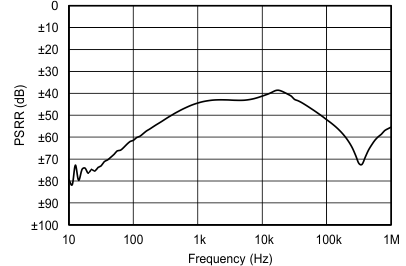
IOUT = No Load